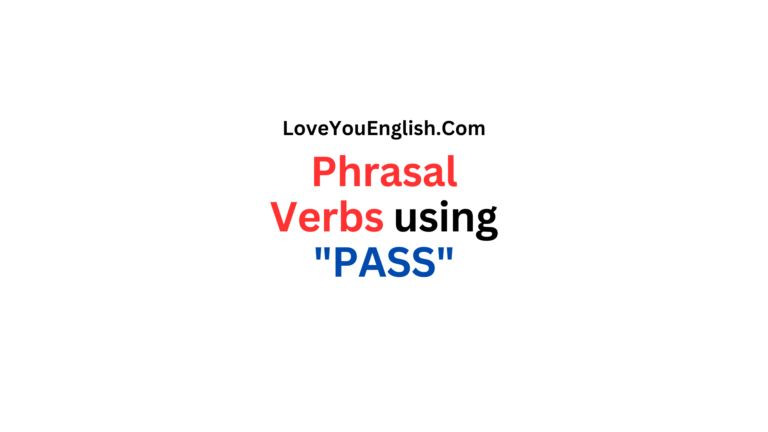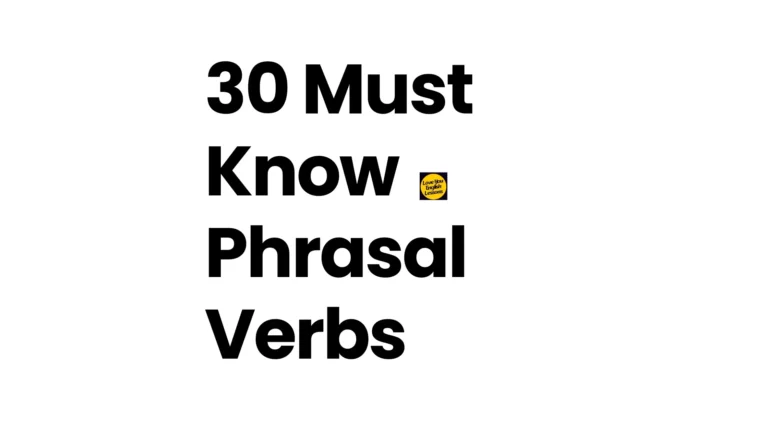Common Mistakes with Phrasal Verbs
Phrasal verbs are an important part of English. They are used in daily conversations, books, and movies. However, they can be tricky for learners because their meanings are not always easy to guess. Many students make mistakes when using phrasal verbs. These mistakes can make speech sound unnatural or unclear.
In this post, I will discuss the most common mistakes with phrasal verbs and give tips on how to avoid them.
What Are Phrasal Verbs?
Before we look at mistakes, let’s first understand what phrasal verbs are. A phrasal verb is a combination of two or three words: a verb and one or two particles (such as a preposition or an adverb).
For example:
- Look after: to take care of something or someone.
- Give up: to stop doing something.
- Run into: to meet someone unexpectedly.
These verbs are not just the meaning of the verb by itself; they have their own unique meaning. For example, “look” alone can mean to see or watch something, but “look after” means to take care of someone or something.
Common Mistakes with Phrasal Verbs
Here are some of the most common mistakes that learners make with phrasal verbs and tips on how to avoid them.
1. Using the Wrong Preposition
One of the most common mistakes learners make is using the wrong preposition or adverb with a phrasal verb. English has many phrasal verbs that seem similar but have very different meanings. Here are some examples:
Mistake: “I’m looking for my keys in the table.”
Explanation: The correct preposition here is “on,” not “in.” When talking about a surface (like a table), we use “on” to show the position. “In” is used for something inside a container or space.
Mistake: “She ran on me in the street.”
- Correct: “She ran into me in the street.”
Explanation: The correct phrasal verb here is “run into,” which means to meet someone unexpectedly. “Run on” means something works or continues without stopping, like a machine or engine.
2. Mixing Up Transitive and Intransitive Phrasal Verbs
Some phrasal verbs are transitive, meaning they need an object (a noun or pronoun), while others are intransitive and don’t need an object. A common mistake is using them incorrectly. Here’s an example:
Mistake: “I turned off the light on.”
- Correct: “I turned the light off.”
Explanation: “Turn off” is a transitive phrasal verb, which means it needs an object (“the light”). You don’t need to add another preposition like “on.”
Mistake: “She looked after to her brother.”
- Correct: “She looked after her brother.”
Explanation: “Look after” is transitive, and you should not add a preposition like “to.” “Look after” already means to care for someone, so just use the object after the phrasal verb.
3. Using Phrasal Verbs in the Wrong Order
Some phrasal verbs can be separable (you can place the object between the verb and the preposition), while others are inseparable. Mistakes often happen when learners don’t know whether the phrasal verb is separable or inseparable.
Separable Phrasal Verbs:
These verbs allow you to separate the verb and the preposition/adverb if you use an object. For example:
- Turn off: “I turned the lights off.” or “I turned off the lights.”
Inseparable Phrasal Verbs:
These verbs cannot be separated. The object always comes after the preposition/adverb. For example:
- Look after: “She looks after her brother.” (You cannot say “She looks her brother after.”)
Here are a few common inseparable phrasal verbs:
- Run into (to meet unexpectedly)
- Look after (to take care of)
- Get along with (to have a good relationship with)
4. Using a Phrasal Verb Instead of a Simple Verb
Sometimes learners try to use a phrasal verb when a simple verb would work better. In many cases, using a simple verb sounds more natural.
Mistake: “I will arrive to the airport at 3 PM.”
Explanation: The verb “arrive” does not need a preposition like “to” when you are talking about reaching a place. You only need “at” to indicate the time.
Mistake: “She is going to get up with her project.”
Explanation: The simple verb “continue” works better here than “get up with.” “Get up” typically refers to standing after sitting or lying down, not continuing an activity.
5. Forgetting to Use the Correct Verb Form
In English, phrasal verbs follow normal verb rules, including tense changes. A common mistake is forgetting to use the correct verb form (like past tense or continuous) when needed.
Mistake: “She gave up studying last year.”
- Correct: “She gave up studying last year.”
Explanation: “Give up” is correct here in the past tense because the sentence is talking about something that happened last year. The mistake is when you forget to change the verb to match the tense.
Mistake: “They are looking after their parents yesterday.”
- Correct: “They looked after their parents yesterday.”
Explanation: When using the past tense, you need to change the verb to “looked” instead of using the present continuous form (“are looking”).
6. Using Phrasal Verbs Too Formal or Too Informal
Some phrasal verbs are very informal, while others are more formal. Using them in the wrong context can make you sound unprofessional or too casual.
Mistake: “I need to go to the bank and pick up some cash.”
Explanation: “Pick up” is very informal when talking about withdrawing money. “Withdraw” is more formal and suitable for official contexts like banks.
Mistake: “He blew up when he heard the news.”
- Correct: “He became very angry when he heard the news.”
Explanation: “Blow up” is informal and refers to becoming very angry. In more formal writing or speech, you could use “became angry” instead.
7. Using Phrasal Verbs That Sound Similar But Have Different Meanings
Many phrasal verbs sound similar but have different meanings, and this can cause confusion. It’s essential to learn the differences to avoid mistakes.
Mistake: “I will take on your job.”
- Correct: “I will take over your job.”
Explanation: “Take on” means to accept responsibility for something, while “take over” means to take control or manage something. So, if you are replacing someone’s job, you should use “take over.”
Mistake: “He ran on the street.”
- Correct: “He ran along the street.”
Explanation: “Run on” means to continue moving or operating, while “run along” means to move in a particular direction, often alongside something.
How to Avoid These Mistakes
Now that you know some of the most common mistakes with phrasal verbs, let’s look at some tips to avoid them:
Practice Regularly: The more you practice, the more familiar you will become with phrasal verbs. Try using them in your daily conversations or writing exercises.
Learn in Context: Always learn phrasal verbs in context. This will help you understand when to use them correctly. For example, learn them with real sentences instead of just memorizing their meanings.
Watch Movies and Listen to Native Speakers: Listening to native speakers will help you understand how phrasal verbs are used naturally in conversation. You can pick up common phrasal verbs and hear how they sound in context.
Use a Dictionary: A good dictionary will not only give you the meaning of phrasal verbs but also provide examples of how they are used. Some dictionaries even show whether the phrasal verb is separable or inseparable.
Avoid Overusing Phrasal Verbs: Sometimes it’s better to use simpler, more straightforward verbs instead of phrasal verbs, especially in formal writing.
Conclusion
Phrasal verbs are an essential part of learning English, but they can be confusing. By understanding the common mistakes and practicing regularly, you will become more confident in using them correctly. Remember to focus on learning phrasal verbs in context, and always pay attention to the prepositions, separability, and formality of the verb you are using. With time and practice, you’ll master phrasal verbs and sound more like a native English speaker.
Read more:
- 30 Phrasal Verbs using “TAKE” with Meanings and Sentences
- 30 Phrasal Verbs using “MAKE” with Meanings and Sentences
- 30 Phrasal Verbs using “BREAK” with Meanings and Sentences
- 30 Phrasal Verbs using “LET” with Meanings and Sentences
- 30 Phrasal Verbs using “GO” with Meanings and Sentences
- 30 Phrasal Verbs using “SET” with Meanings and Sentences
- Oxford English Grammar
- Cambridge Grammar of English
- Purdue Online Writing Lab (OWL) – Grammar
- Grammarly’s Grammar Guide







